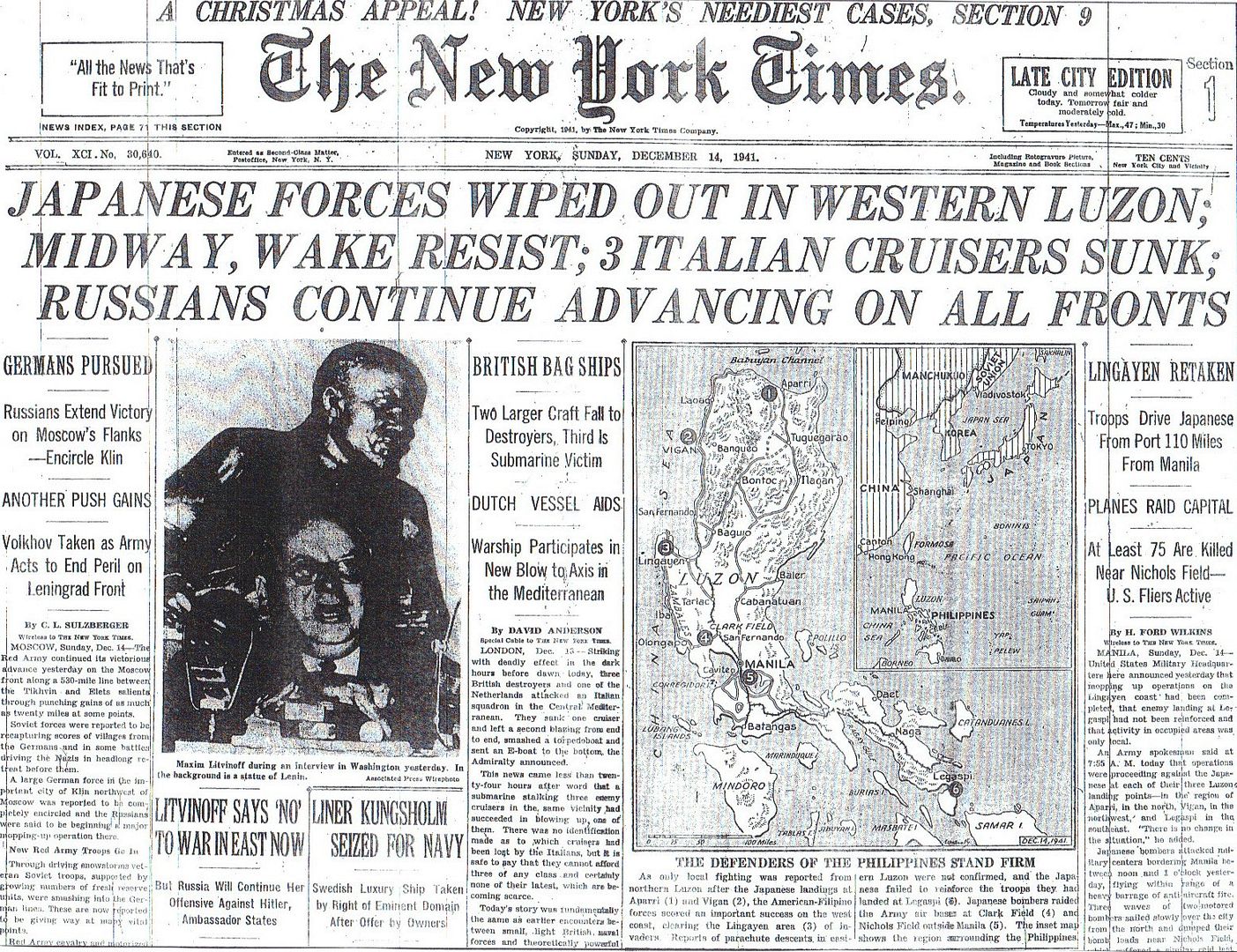
Posted on 12/14/2011 4:44:24 AM PST by Homer_J_Simpson

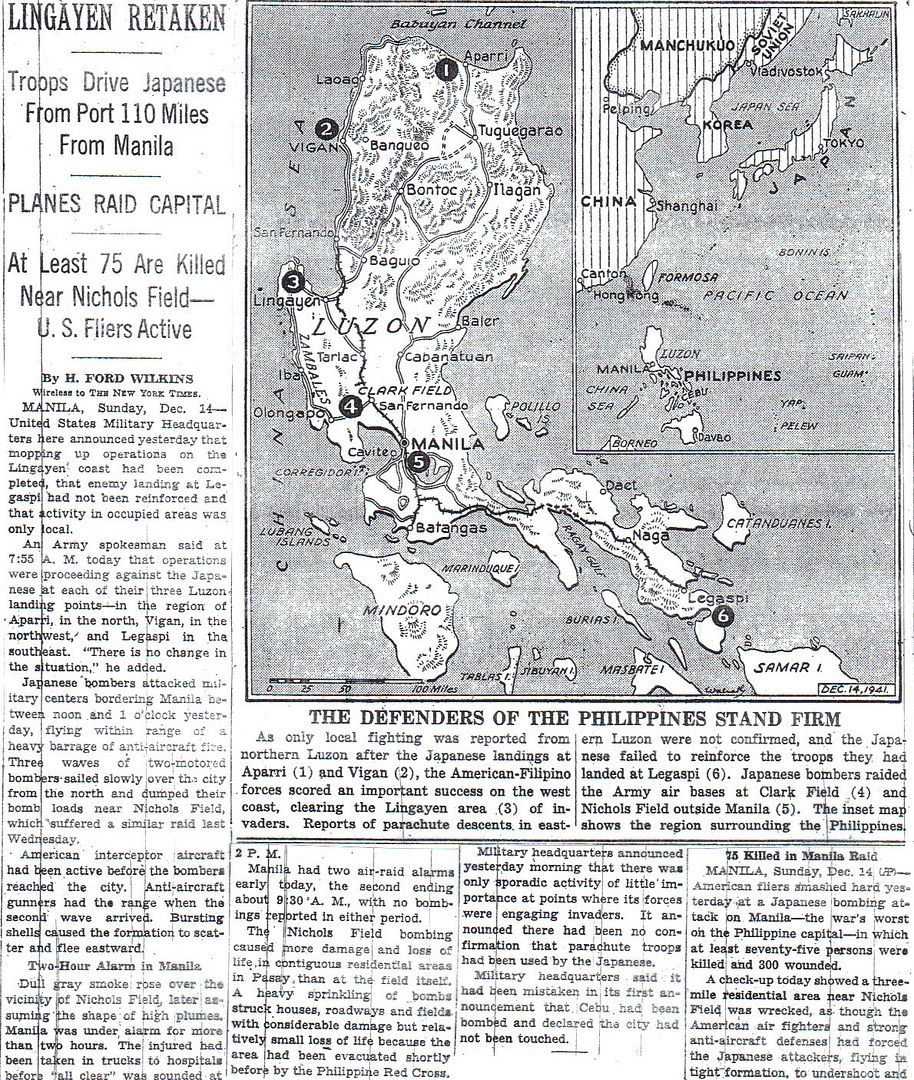
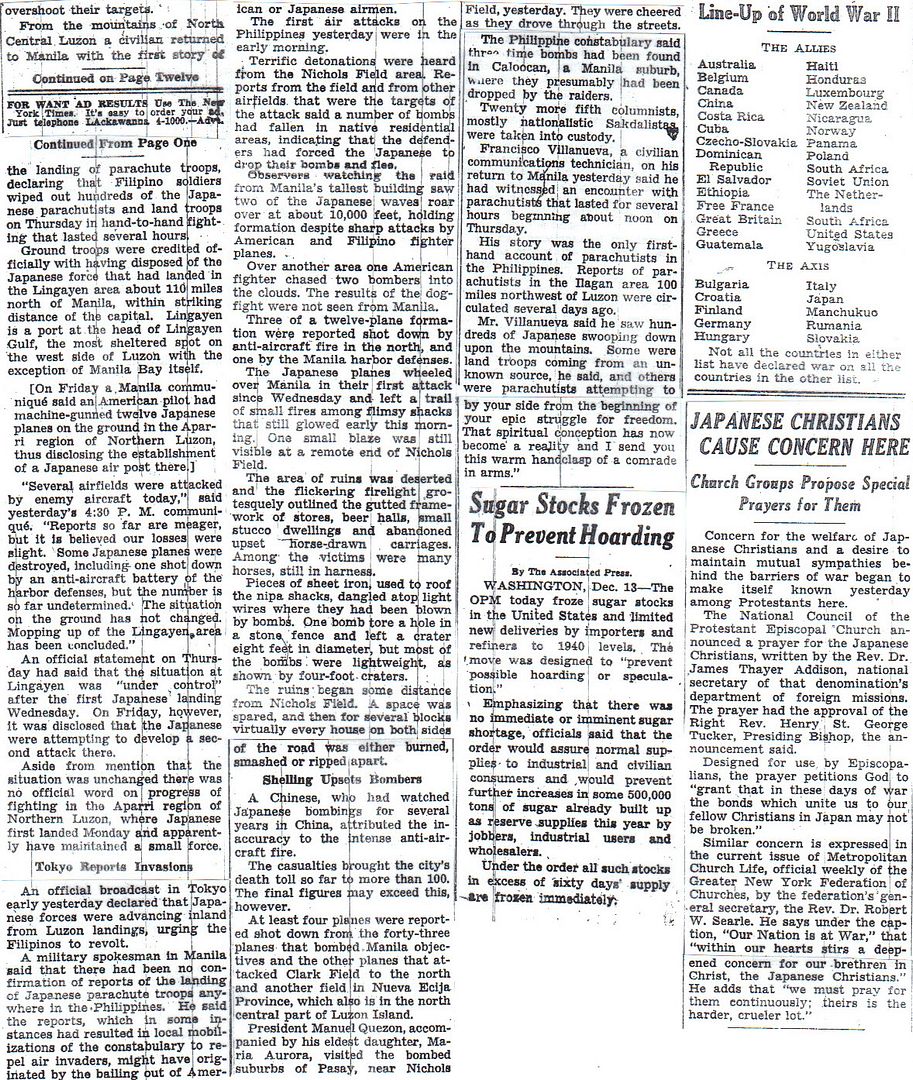

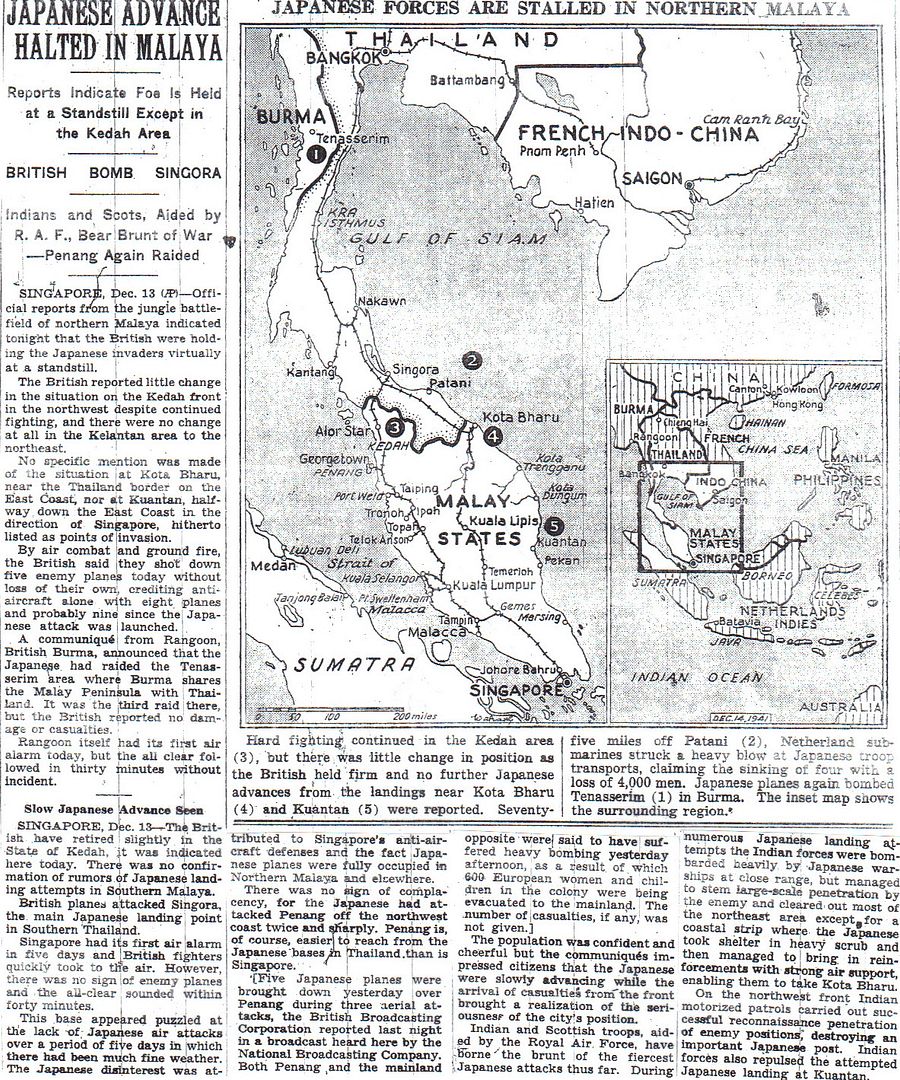
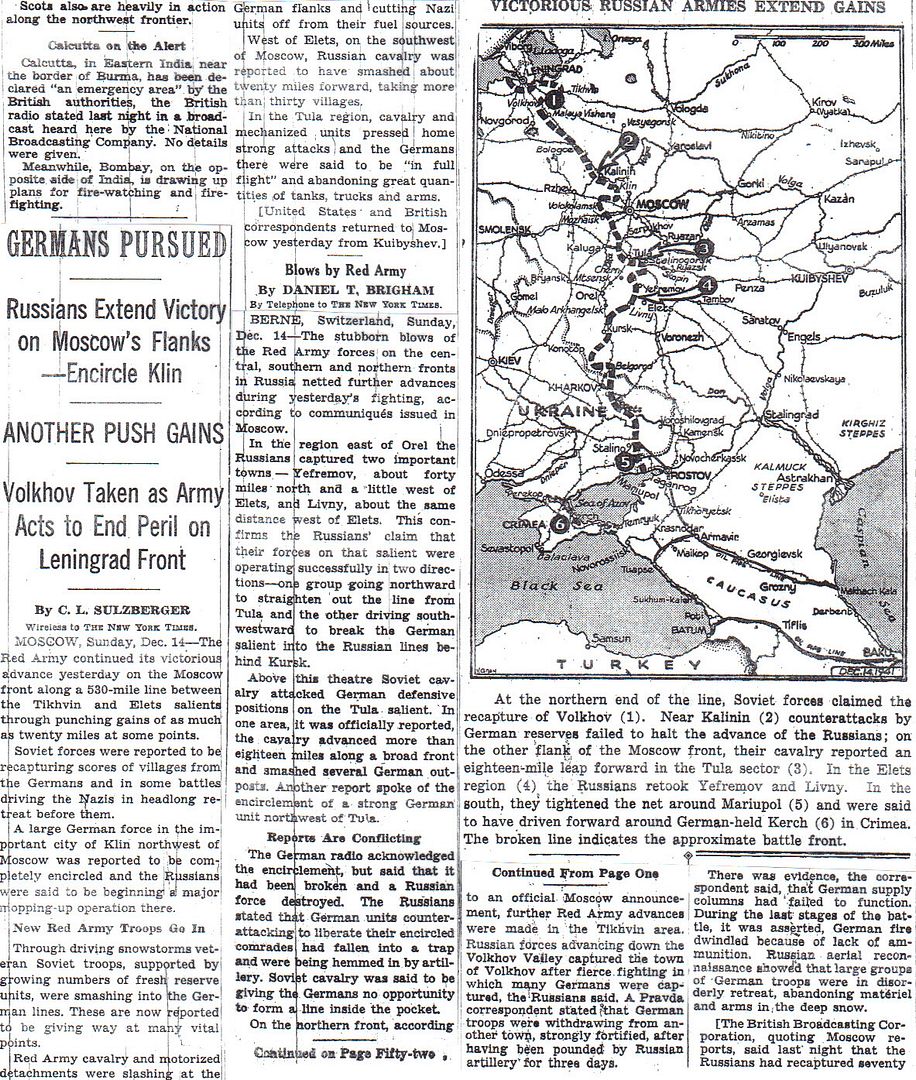
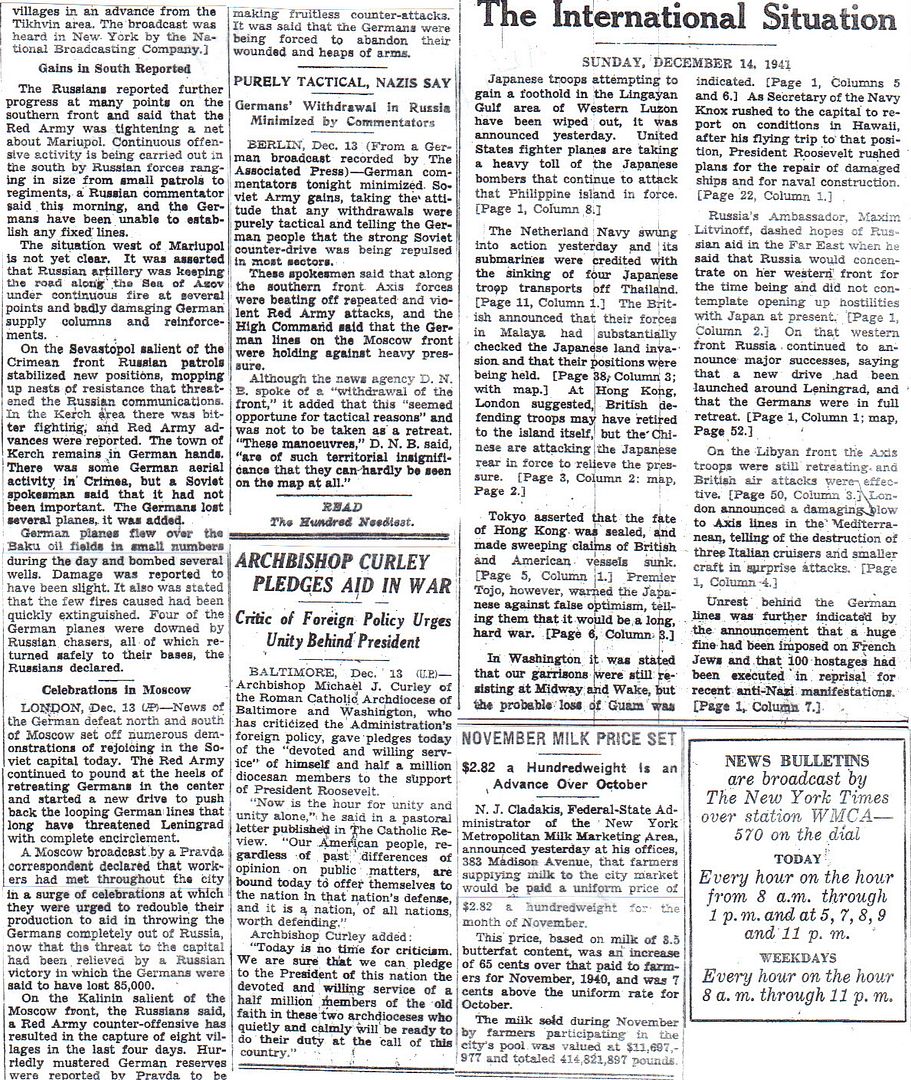
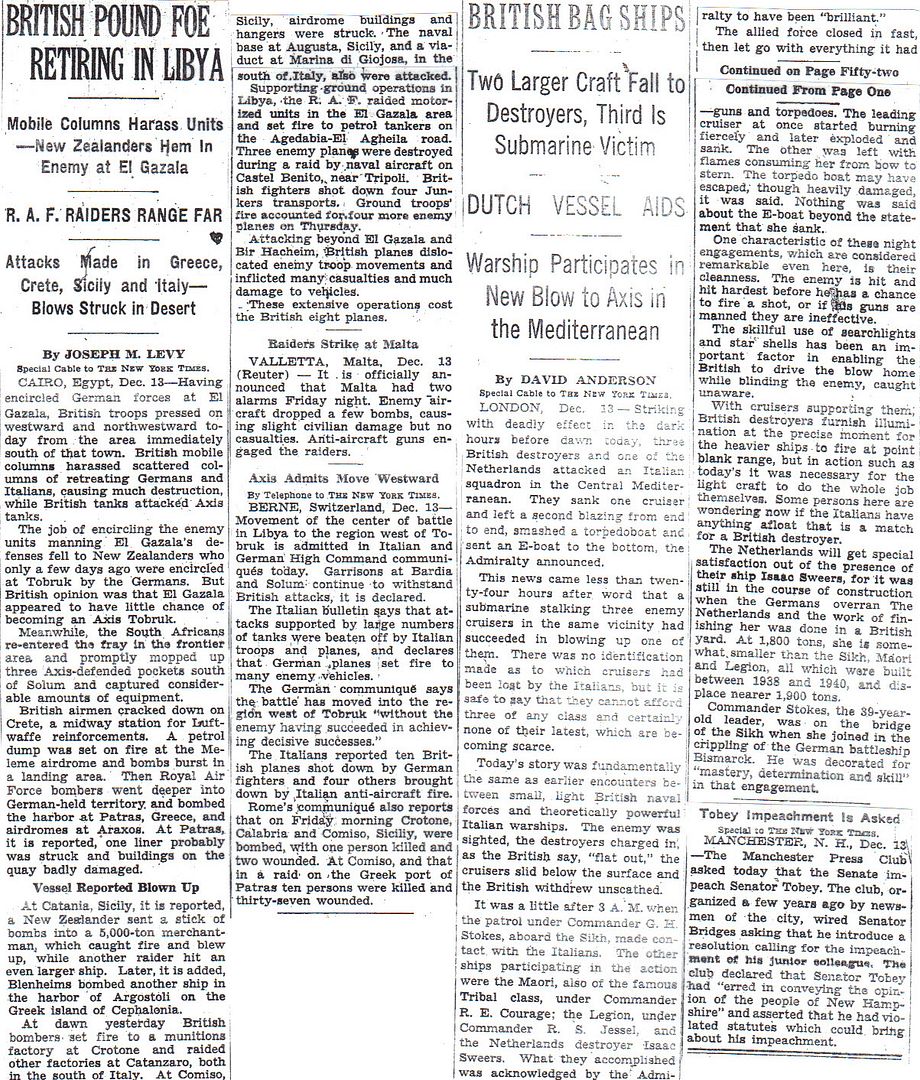
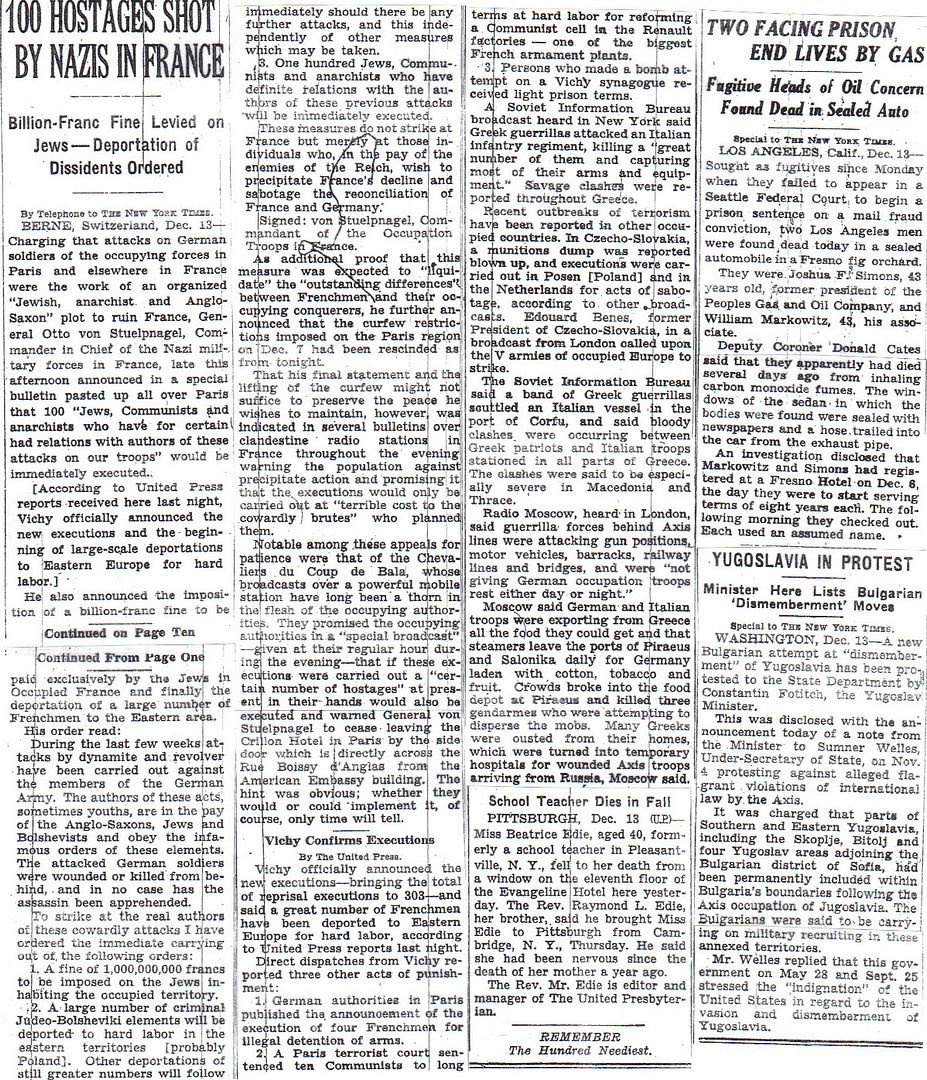



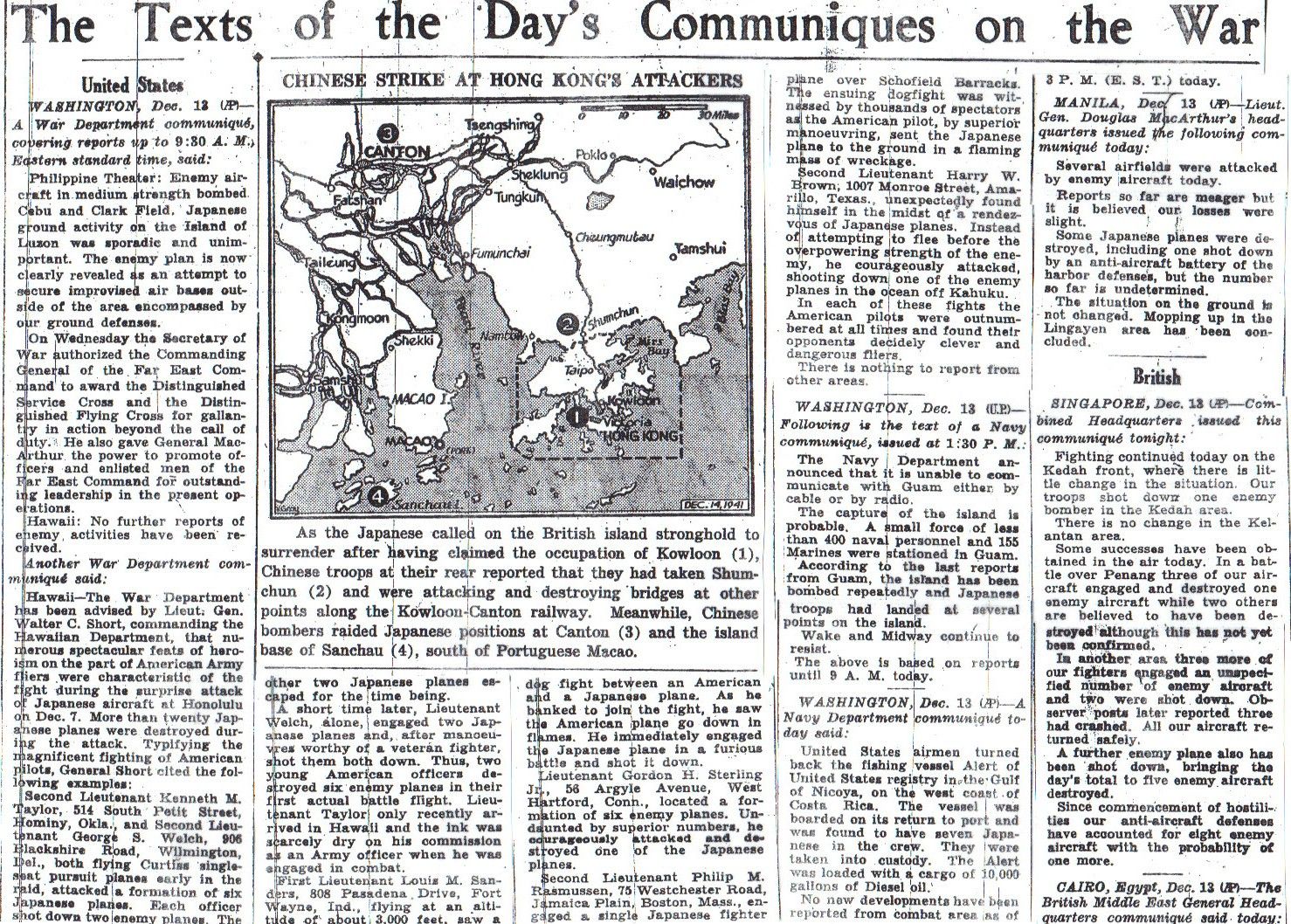
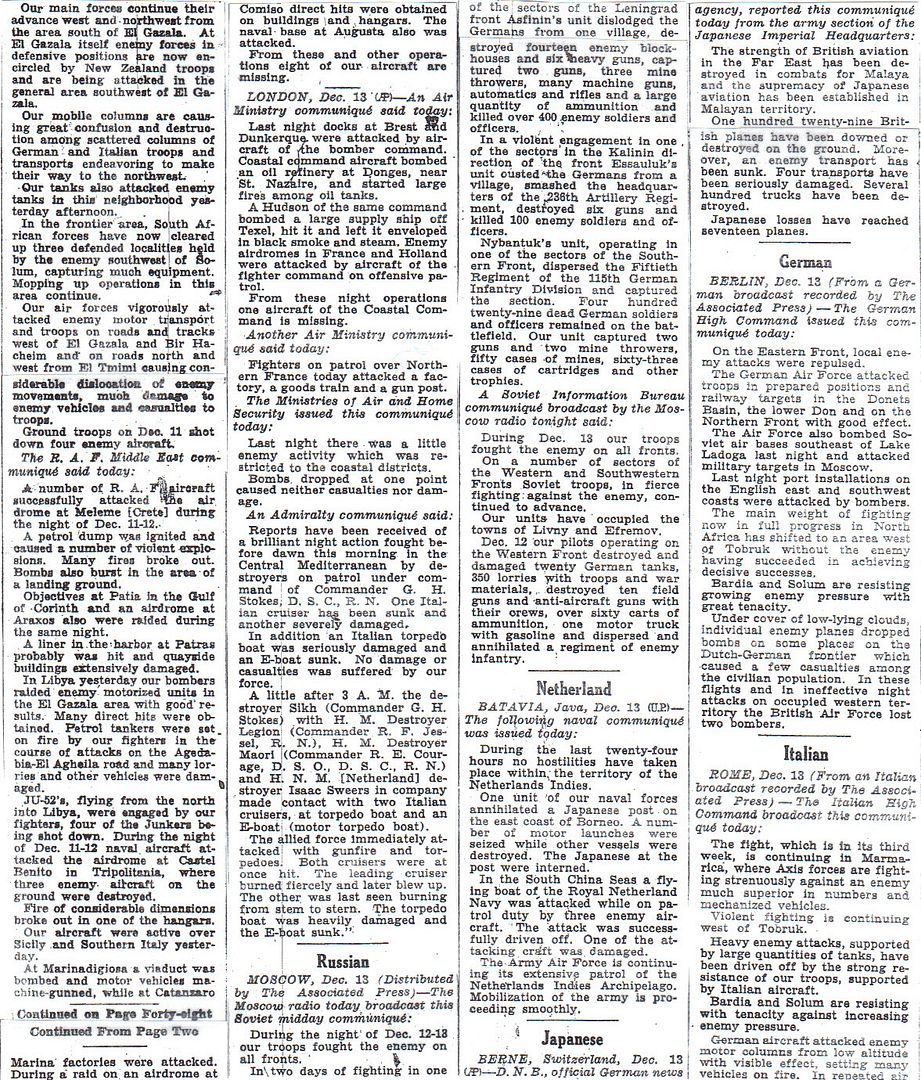
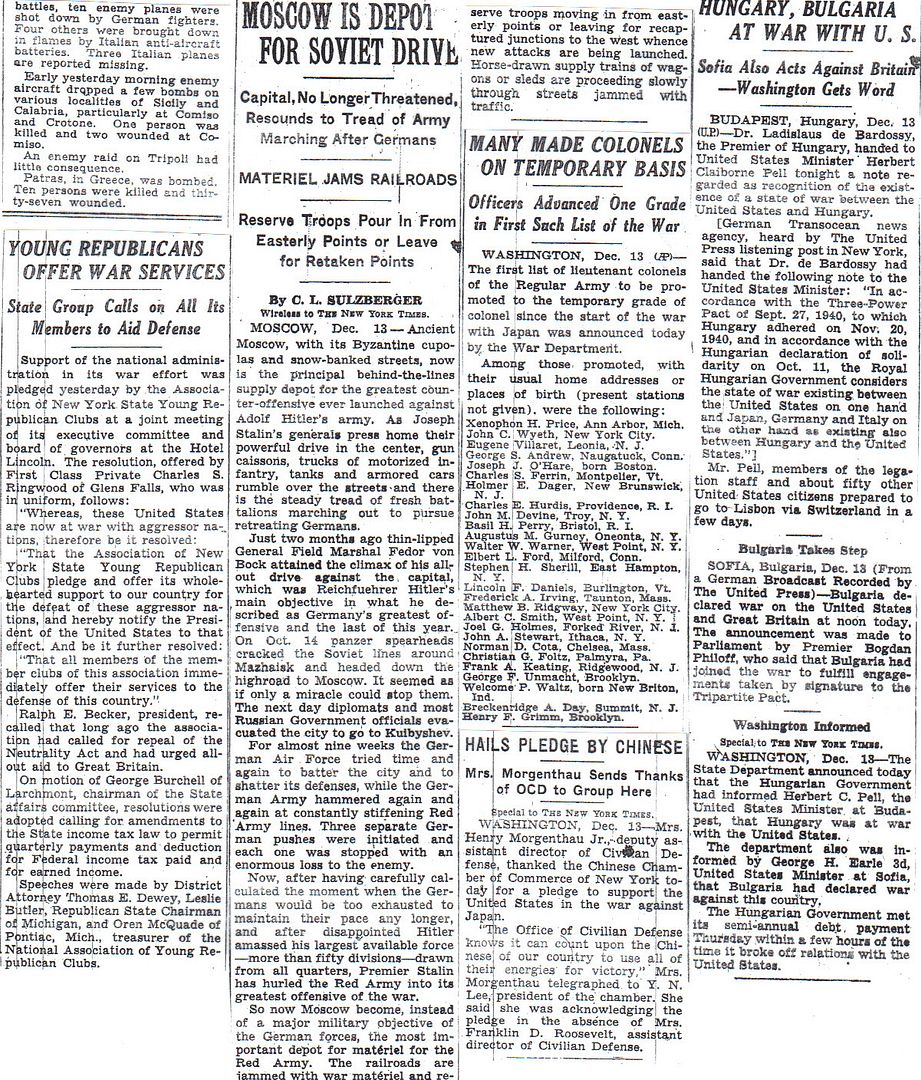



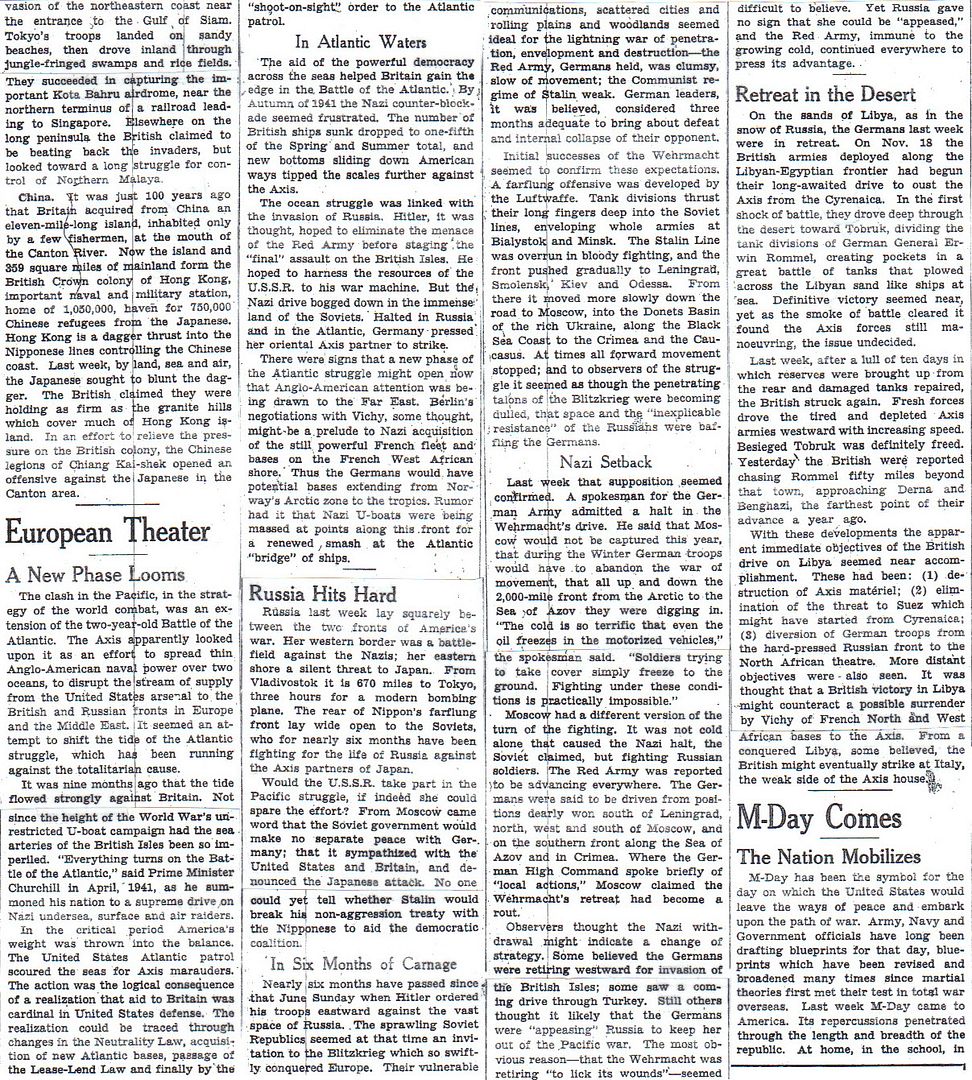





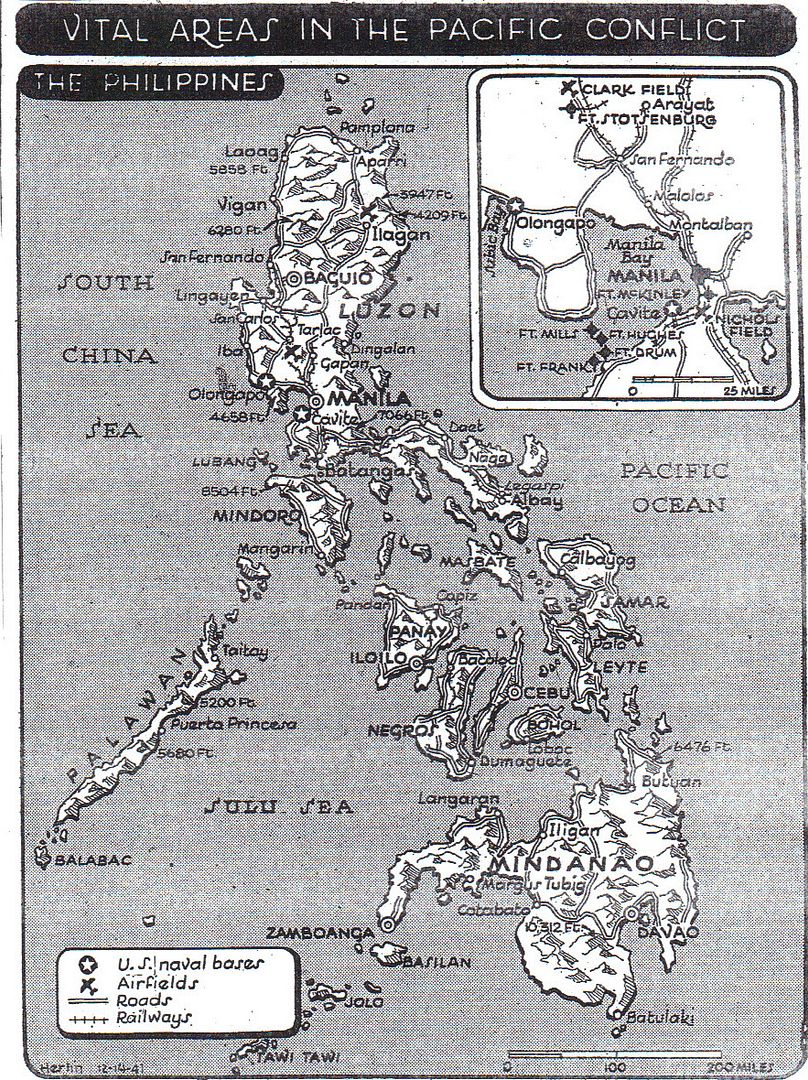

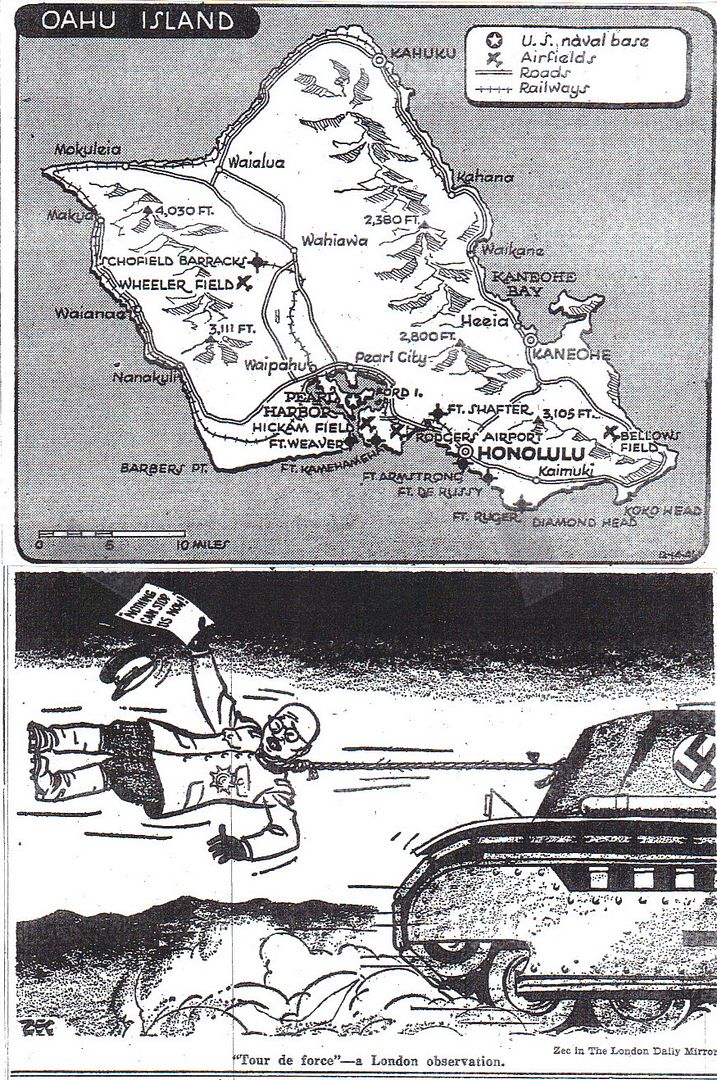
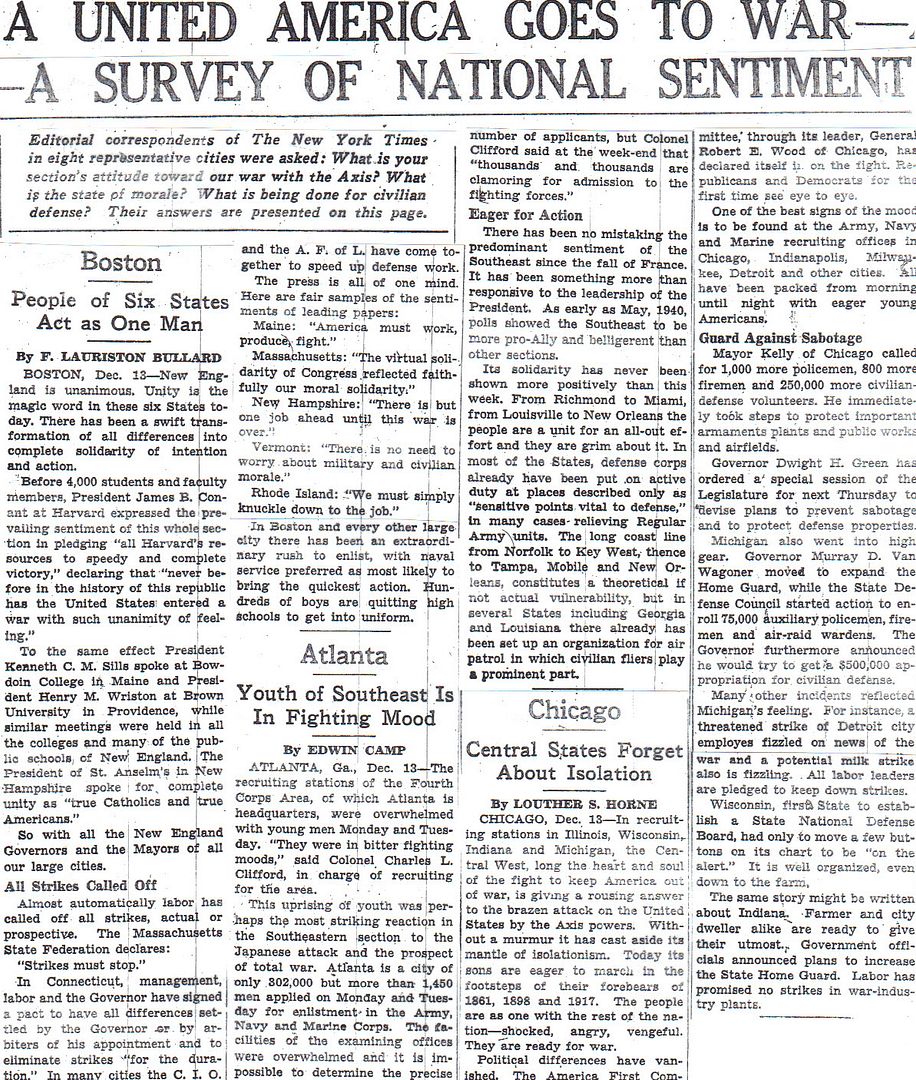

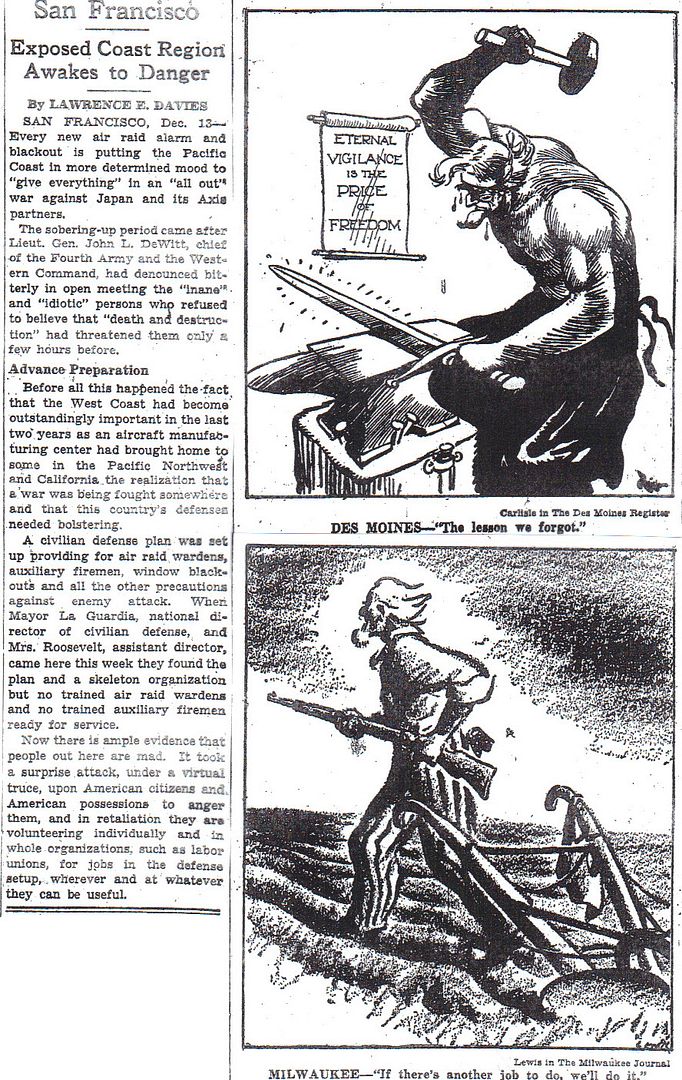
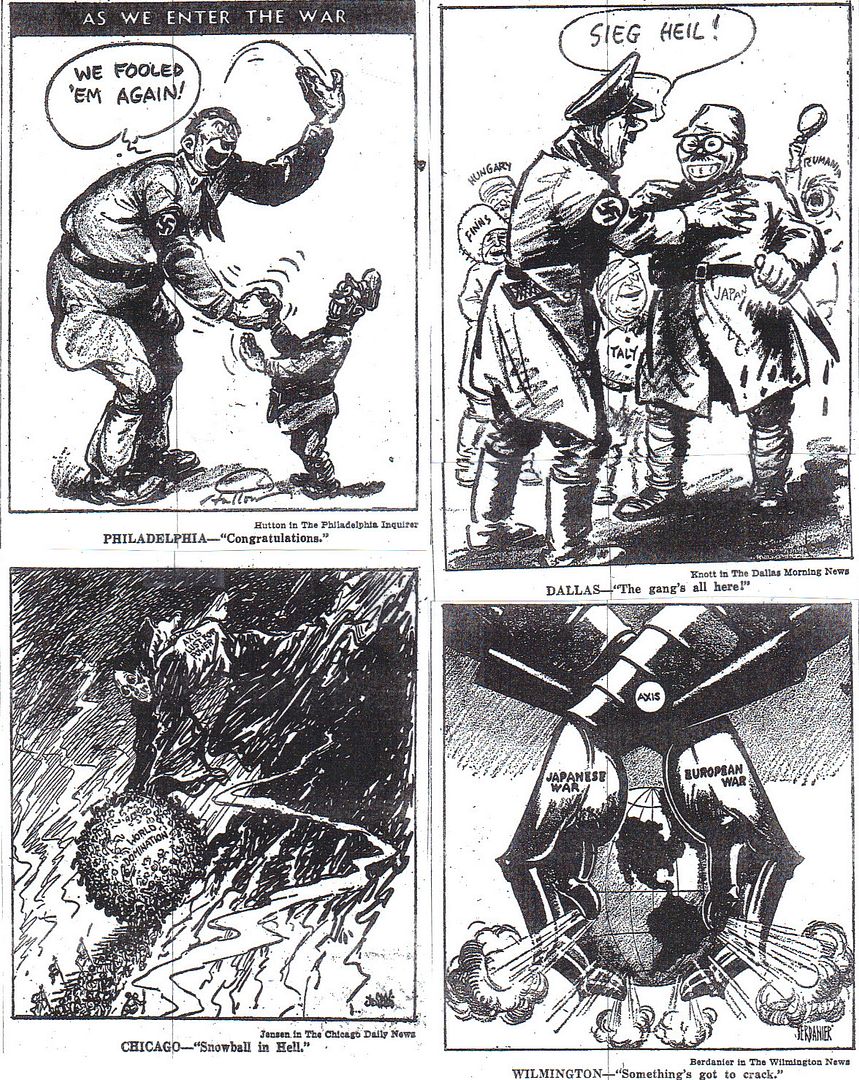
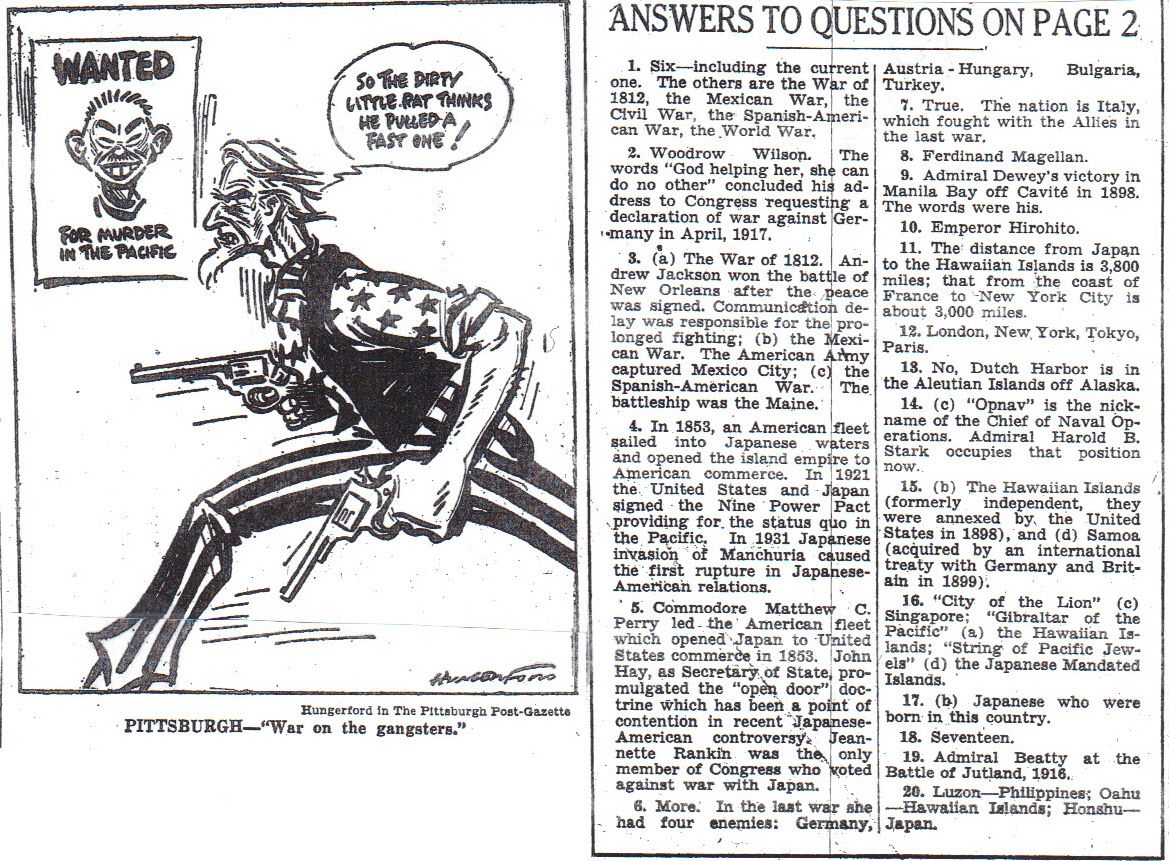
Lingayen Retaken – 2-3
Two U.S. Isles Holding Out, but Guam is Believed Lost – 4
Germans Pursued – 6-7
The International Situation – 7
British Bag Ships – 8
100 Hostages Shot by Nazis in France – 9
The Texts of the Day’s Communiques on the War – 13-15
The News of the Week in Review
World War II – 17
Asiatic Theatre – 17-19
European Theatre – 19
M-Day Comes – 19-20
In the Pacific Arena – 20-21
Twenty News Questions – 21
War Must be Fought on Two World Fronts (by Hanson W. Baldwin) – 22-27
A United America Goes to War-A Survey of National Sentiment – 28-32
Answers to Twenty News Questions - 32
I found my first error. I asked the on duty mods to fix the title. I left out FORCES WIPED.
http://www.onwar.com/chrono/1941/dec41/f14dec41.htm
Japanese advancing in Malaya
Sunday, December 14, 1941 www.onwar.com
Japanese soldiers advancingIn Malaya... Japanese forces continue advances from “The Ledge” to Kroh.
In the Mediterranean... The Italian battleship Vittorio Venito, part of a convoy to Benghazi is sunk. Italians turn convoy back.
In the North Atlantic... Convoy HG-76 containing 32 ships sails from Gibraltar for Britain. Its escort is commanded by Commander Walker and his force includes the escort carrier Audacity and twelve other ships.
http://homepage.ntlworld.com/andrew.etherington/month/thismonth/14.htm
December 14th, 1941
GERMANY: U-757 launched. (Dave Shirlaw)
SPAIN: U-434 refuelled from the German supply ship Bessel in Vigo. (Dave Shirlaw)
MEDITERRANEAN SEA: The Italian battleship Vittoria Veneto is damaged by a British submarine while escorting an Italian convoy to Benghazi, Libya. This with previous losses prompts the Italians to recall the convoy.
Cruiser Galatea is torpedoed by U-577 (OLtzS. Ottokar Paulshen, CO). She is hit by multiple torpedoes and sinks in three minutes, 30 miles West of Alexandria at 31 12N 29 15E. There are 470 casualties but 144 survivors are rescued by HMS Griffin and Hotspur. (Alex Gordon)(108)
MALAYA: The Japanese force advancing from Patani has reached Kroh.
CANADA: Minesweeper HMCS Port Hope launched Levis, Province of Quebec. (Dave Shirlaw)
U.S.A.: The USAAF 77th Bombardment Squadron (Medium) departs Gowen Field, Boise, Idaho destined for Alaska. (Jack McKillop)
ATLANTIC OCEAN:
U-108 sank SS Cassequel.
U-160 lost 7 men dead and one wounded in a fire at Danzig during the boat’s working up exercises.
Oblt. Hans-Jürgen Radke of U-657 was killed in a fire on the living quarters ship Black Prince. That fire killed 28 men. The boat was still going through trials at the time.
U-A met the Italian submarine Luigi Torelli in the mid-Atlantic and transferred 50 survivors from the German support ship Python and Atlantis. (Dave Shirlaw)
....General Douglas Mac Arthur should have been removed from command....he HAD forewarning of an attack of the Philippines, acknowledged the situation but got caught with his pants down and his planes on the ground....he lost most of his planes ON THE GROUND....and only kept his command as he had garnered some sort of popularity with Washington...
Some of those cartoons are raaaaacist.

Admin moderator rocks! I believe I will slip an extra ten spot into his or her Christmas stocking to prime the pump for the first 2012 freepathon.
MacArthur is the American military man most hated by the left and the left has done more to smear and rewrite his history than any other general. MacArthur had forewarning and did act on it by ordering operational fighters and bombers into the air.
he lost most of his planes ON THE GROUND.
Most planes were lost on the ground but that's probably where they were most useful. Air fields in the Philippines were not large enough to permit dispersal and by leaving worn out and obsolete aircraft on the ground, their pilots and crews were saved.
Much has been written about the number of aircraft destroyed on the ground on Dec 8, 1941 but very rarely is mention ever made that of the generally cited 300 planes in the Philippines, the vast majority of destroyed aircraft were obsolete, worn out and were best left on the ground as decoys.
On Dec 7 in the Philippines, there were 54 operational P-40E's, 18 P-40B's and 18 P-35's. The P-35's listed as operational were effectively useless due to worn out engines, worn out .30 cal machineguns, light armor and no self sealing fuel tanks but of the 18 P-35's that were listed as operational, only a few of them actually made it into combat with the others having to return to base or be abandoned due to mechanical problems.
One of the P-40 squadrons had just arrived and the engines had not yet been broken in nor guns sighted but were never-the-less listed as operational. Of the freshly arrived P-40's, only a few of them made it from scramble into combat due to brand new unbroken engines blowing out. Many American pilots would fire their guns for the first time against Japanese aircraft.
None of the fighters, P-40 or P-35 had oxygen for the pilots. Lack of oxygen limited use to about 15,000 feet. Even the P-40E's would not have lasted very long because the Japanese bombers could fly much higher than the American fighters and bomb airfields with impunity.
The 34 B-17's in commission on Dec 7, had gunners that had never even fired a machinegun. Furthermore, they didn't even have tailgunner positions.
Previous commentary on Gen. MacArthur has all been critical. Thanks for pointing out some intriguing mitigating factors. It reminds me of the suggestion that the USN was better off being completly surprised by the Pearl Harbor attack than getting a day or so warning so they could go out and meet the foe.
Politics has nothing to do with it. MacArthur’s conduct of the 1941-1942 Philippines campaign was abysmal.
Even though he knew war was coming, he did not take enough steps to prepare his command. Specifically, the failure on his part to move supplies to Bataan at he start of the war, or even before the war when tensions increased. He did not start moving supplies until well after the war started, a critical failure on his part that led to the early defeat of the USAFFE forces on Bataan.
Logistics is the key to winning a war, and MacArthur’s utter disdain for it cost his troops dearly.
In addition, he:
...instead of following prewar plans, he tried a “fight them on the beaches strategy” that his troops were simply not capable of implementing.
... did not place his forces on a full alert after receiving the war warning in late November of 1941. Instead he continued to operate on mostly a peacetime basis. B-17s that were due to move to Del Monte field on Mindanao stayed on Luzon so that a party could be thrown for them. Not acceptable with war imminent. The aircraft at Clark should have been dispersed, the auxiliary fields should have been completed faster. But MacArthur had convinced himself that war was not coming until spring, despite all evidence to the contrary.
...accepted secret cash payments from the Philippine government (for services before the war) that was inappropriate for him to accept while his troops were fighting, starving and dying on Bataan and while a large chuck of the Philippines was already under enemy occupation.
... he painted himself as a hero of Bataan when he made exactly one visit to the peninsula during the siege. And generally used US Army resources to promote himself instead of the troops under him.
MacArthur failed to prepare his command for war and failed to use his forces properly after war started.
Had another competent commander been in charge, the Philippines would have held out longer (possibly 9 months to a year) and would have drawn in significantly more troops derailing Japanese plans elsewhere.
Thanks. The all out attack on MacArthur by the left is such that you really can't rely on any information related to the onset of war in the Philippines aside from that available prior to Dec 8, 1941 and first hand accounts compiled from surviving commanders after the war.
Give me an example of a commander in that period whose performance was stellar. They fought with what they had which was next to nothing. If you want a scapegoat, look to FDR.
Even though he knew war was coming, he did not take enough steps to prepare his command. Specifically, the failure on his part to move supplies to Bataan at he start of the war, or even before the war when tensions increased. He did not start moving supplies until well after the war started, a critical failure on his part that led to the early defeat of the USAFFE forces on Bataan.
Unless you can cite criticism from the 1940's into the early 1950's by officers who were in theater, you make your claims only due to the clarity of vision offered by hindsight.
Logistics is the key to winning a war, and MacArthur’s utter disdain for it cost his troops dearly.
In an alternate universe, what would the difference have been? The troops could not have been resupplied until 1943 at the earliest.
... did not place his forces on a full alert after receiving the war warning in late November of 1941.
Instead he continued to operate on mostly a peacetime basis. B-17s that were due to move to Del Monte field on Mindanao stayed on Luzon so that a party could be thrown for them.
From where do you get your information about such a party?
The aircraft at Clark should have been dispersed,
Clark was unfortunate in that the anticipated early morning attack did not materialize. This appears to have been due to Formosa being socked in by heavy fog. American fighters were never-the-less ordered up on patrol. At noon, the fighters had just returned from patrol and were on the ground being refueled when the Japanese attack came. Simultaneously, the B-17's were having their bomb loads changed in preparation for an attack of Formosa. The problem for Clark was not one of dispersal but rather fog over Formosa prevented Japanese planes from taking off earlier (It also prevented an earlier American B-17 attack). The Japanese attack on Clark did not come until noon and with no early warning. The sirens at Clark didn't start wailing until bombs were already falling from the sky.
Had another competent commander been in charge, the Philippines would have held out longer (possibly 9 months to a year) and would have drawn in significantly more troops derailing Japanese plans elsewhere.
What difference would it have made? They were not going to be resupplied in 1942.
I know we’ve seen and heard “second World War” several times now, but I believe this is the first time I’ve seen “World War II”.
Likewise. Another noteworthy item in today's edition is on #15. Congratulations are in order for freshly minted Colonel Welcome P. Waltz.
I wish my laptop wasn’t down right now (waiting for a new cooling fan), its hard to do anything from my wife’s computer, otherwise I would go into this in more detail and may still after I have my computer back.
I will say that the left doesn’t have a lot of trouble demonizing MacArthur because he really was that incompetent. Many of the items I’ve looked at on the man has nothing to do with the left’s attempts to smear the man because it is primary source material. No analysis, just the documentation that was generated at the time he made the missteps he did.
Just for example, I know I have mentioned that MacArthur received a tidy little payoff from President Quezon as things were quickly going south in January 1942. MacArthur was paid to his personal account from the Philippine treasury, $500,000 dollars. The motivation for the president of the Philippines to do this was most likely due to the protection MacArthur could allot to Quezon and his family even if Japan took over the entirety of the Philippines (Which when the money was ordered transferred on January 3rd this was already pretty evident).
This can all be traced to primary documentation and has nothing to do with a leftist smear campaign.
The order to give MacArthur the money is called Executive Order #1 and can be found in the personal papers of Manuel Quezon in the Philippine National Library. A trail of how that money moved afterwards can be found in National Archive files including Files of Division of Territories and Island Possessions, “9-7-4 Banking,” Legislative and Natural Resources Branch, as well as a thank you letter from Quezon to MacArthur that mentions Executive Order #1 from February 20, 1942 that’s located in Record Group 10, VIP files, MacArthur Memorial Bureau of Archives, Norfolk, VA.
I could go on but I have to run up to the university now sans laptop. grrr!!!!!
I look forward to your upcoming post.
Just for example, I know I have mentioned that MacArthur received a tidy little payoff from President Quezon as things were quickly going south in January 1942. MacArthur was paid to his personal account from the Philippine treasury, $500,000 dollars. The motivation for the president of the Philippines to do this was most likely due to the protection MacArthur could allot to Quezon and his family even if Japan took over the entirety of the Philippines (Which when the money was ordered transferred on January 3rd this was already pretty evident).
That's just a drop in the bucket compared to the total compensation MacArthur received from Quezon. Remember, MacArthur held the rank of Field Marshal in the Philippine army.
Off the top of my head, I don't recall if MacArthur said there were any agreements between he and FDR concerning dual loyalties as condition for his coming out of retirement in late July 1941.
Keep in mind when piling blame for loss of the Philippines on MacArthur that he only took command of U.S. forces in the Philippines barely four months before the Japanese attacked.
I would hardly call $500,000 in 1941 dollars a drop in the bucket, but he did receive a rather large salary as well. Again from the VIP papers, he received a salary as Field Marshal of 36,000 pesos a year (about 18k U.S.) and a petty cash fund of another 30,000 pesos, (15k U.S.). That is a pretty large salary even for a Field Marshal. MacArthur also insisted on being provided with a seven room fully air conditioned suite at the Manila Hotel.
Also, it is important to note that MacArthur was in command of the forces on the Philippines since the end of 1935 (though I think he didn’t actually arrive in the Philippines until the beginning of 1936). MacArthur was specifically sent to the Philippines to develop the Filipino Army. This “citizen army” that MacArthur had been trying to develop represented a large contingent of the combatants against the Japanese. Even the U.S. forces he inherited only four months before the beginning of hostilities were composed of over 50% Filipino Scouts. MacArthur had a pretty heavy hand in the composition of the defenses on the Philippines for the last 5 years, so it’s hard to give him a pass just because the 11,000 some odd Americans added to his forces were a last minute addition.
Disclaimer: Opinions posted on Free Republic are those of the individual posters and do not necessarily represent the opinion of Free Republic or its management. All materials posted herein are protected by copyright law and the exemption for fair use of copyrighted works.